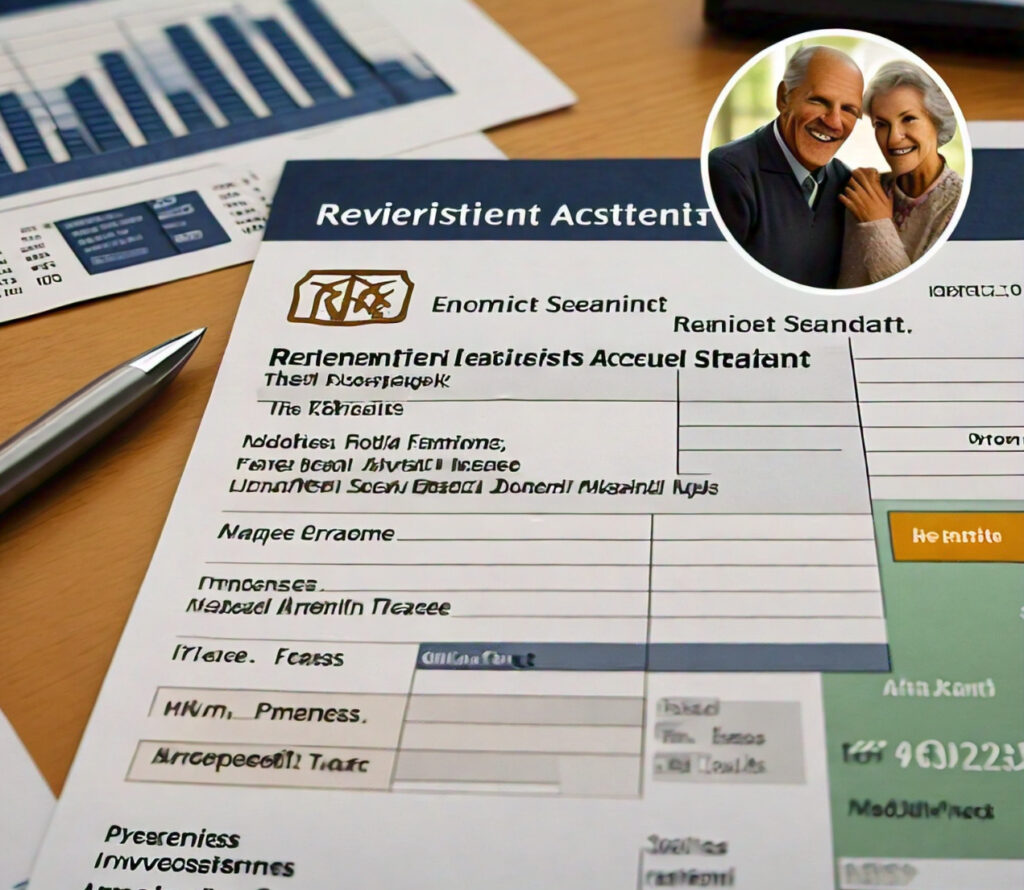Setting up a retirement plan is one of the most valuable ways to ensure security in your financial future. Perhaps the biggest decisions concerning retirement planning relate to choosing between retirement account types. With all the available retirement account types, it may be rather overwhelming to choose which one may suit your needs best. This article discusses three of the most common types of retirement accounts: 401(k)s, Traditional IRAs, and Roth IRAs.

We will take an in-depth look at each of them and see how they are set up, the good things they offer, and possible disadvantages. By the end of the article, you’ll have a good grasp of how these accounts work and be better equipped to make informed decisions when it comes to your retirement savings strategy. Whether you just started your career or simply need more optimization for your existing retirement plan, this guide will have some crucial details about the world of retirement accounts.
Understanding 401(k) Plans
Let’s start with the most widespread retirement savings plan: the 401(k) plan.
What is a 401(k)?
The 401(k) is an employer-sponsored retirement savings plan. Under this, the employee saves and invests a part of his or her paycheck before certain taxes are deducted from the income. As its name suggests, these plans are named after a section of the U.S. Internal Revenue Code.
Key Features of 401(k) Plans
- Employer Sponsorship: 401(k) plans are employer-sponsored plans as part of their benefit package.
- Tax-Deferred Contributions: One can contribute to it before taxes, which lowers the total amount of your income for that year that is considered taxable.
- Employer Matching: Most employers have a matching plan in which they match part of your contributions-a form of free money going into one’s retirement.
- Higher Contribution Limits: In the year 2024, a person below 50 years may contribute an amount of up to $23,000 annually to a 401(k), and for a person 50 or above, he or she may contribute up to $30,500 per year.
- Investment Choices: In many 401(k) plans, there are options available for investment choices such as mutual funds and target-date funds.
- Vesting Schedules: The employer contributions may be subject to a vesting schedule, meaning you have to stay with the firm for some duration of time before you are able to take all the employer-contributed dollars with you when you leave.
Benefits of 401(k) Plans
- Automated Savings: The amount is directly deducted from your paycheck, which may help one save more on a regular basis.
- Tax Advantages: Contributions lower your taxable income, and thus can lower your current tax bill.
- Employer Matching: This is essentially free money that can greatly increase your retirement savings.
- Higher Contribution Limits: You can invest more money in a 401(k) than in an IRA.
- Borrowing from Your Account: Many 401(k) plans let you borrow from the account, although this is a bad thing for most people, if it can be avoided.
Possible Drawbacks with 401(k) Plans
- Poor Investment Options: You’re stuck with whatever options are offered by your plan.
- Fees: Some 401(k) plans charge high fees that work their way into returns over time.
- Early Withdrawal Penalties: If you withdraw money before the age of 59½, there could be a penalty of 10% in addition to income taxes.
- Required Minimum Distributions (RMDs): You are compelled to begin the distribution from your 401(k) at the age of 72 – in accordance with 2024 requirements – whether or not you need the money.
Delving into Traditional IRAs
Now let’s delve into Individual Retirement Accounts, starting with the Traditional IRA.
What is a Traditional IRA?
A Traditional IRA is simply an individual retirement account that provides possible tax-deferred growth for your retirement objectives. Unlike the 401(k), it does not emanate from an employer.
Key Features of Traditional IRAs
- Individual Account: You establish and maintain the account-your employer doesn’t.
- Tax-Deferred Growth: Your investments grow tax-free until you withdraw the money in retirement.
- Possible Tax Deduction: Your contributions might be tax-deductible depending on your income and whether you are covered under an employer-sponsored retirement plan.
- Lower Contribution Limits: For the year 2024, you can contribute up to $7,000 annually if you are below 50 and $8,000 if you are 50 or over.
- Variety of Investment Options: You can invest in stocks, bonds, mutual funds, ETFs, and a lot more.
- No Income Limits to Constrain Contributions: Anyone with earned income can contribute to a Traditional IRA; no such thing as ‘too much money’ that would disqualify someone from investing in it.
Benefits of Traditional IRAs
- Tax-Deferred Growth: The growth is tax-free until you begin withdrawing at your retirement.
- Tax Deduction Possible: If you are qualified, you can deduct your contribution from your taxable income.
- Investment Flexibility: You can select from a range of available investment options.
- No Requirement for an Employer: You do not need to have an employer-sponsored plan to open and contribute to a Traditional IRA.
Possible Cons of Traditional IRAs
- Lower Contribution Limits: You are unable to save as much money in an IRA as you can in a 401(k).
- Required Minimum Distributions (RMDs): As with 401(k)s, RMDs from Traditional IRAs are required beginning at age 72.
- Early Withdrawal Penalties: If you withdraw money before age 59½, you might have to pay a penalty of 10%, plus any income taxes owed.
- Tax Deduction Income Limits: If either you or your spouse is covered through a workplace retirement plan, the deductibility of your Traditional IRA contribution is phased out at higher levels of income.
Introduction The Roth IRA offers a unique manner of retirement savings, quite different from those of Traditional IRAs and 401(k)s.
What is a Roth IRA?
A Roth IRA is an individual account with tax-free growth and retirements. It is named after Senator William Roth, the sponsor of the legislation creating this kind of account.
Key Features of Roth IRAs
- After-Tax Contributions: You make contributions using money which you have already paid income tax on.
- Tax-Free Growth: The investments in your account grow tax-free.
- Tax-Free Withdrawals: Provided you meet the conditions, you can withdraw your contributions and earnings tax-free during your retirement.
- No Required Minimum Distributions: Unlike Traditional IRAs and 401(k)s, Roth IRAs are not subject to RMDs during the owner’s lifetime.
- Income Limits: There are income limits to contributing to a Roth IRA.
- Contribution Limits: The same as Traditional IRAs in 2024: $7,000 if you’re under 50, and $8,000 if you’re 50 or over.
Advantages of Roth IRAs
- Tax-Free Withdrawals: If you are in a higher tax bracket at retirement, this could be a huge advantage.
- No RMDs: Allowing your money to continue to grow tax-free throughout your lifetime.
- Flexibility: You can withdraw your contributions anytime without penalty – not earnings.
- Estate Planning Benefits: Roth IRAs can be a very effective mechanism of leaving tax-free money to your heirs.
Possible Disadvantages with Roth IRAs
- No Immediate Tax Benefit: Since the money put into an IRA is after-tax dollars, there is no tax deduction in the year of contribution.
- Income Limits: If you make more money, you can’t put money directly into a Roth IRA.
- Five-Year Rule: You must have had your Roth IRA for at least five years to withdraw earnings tax-free in retirement.
Comparing 401(k)s, Traditional IRAs, and Roth IRAs
Having covered each account type individually, we should discuss them together side by side.
Tax Treatment
- 401(k): Contributions are pre-tax, reducing your current taxable income. Withdrawals in retirement are taxed as ordinary income.
- Traditional IRA: Contributions may be tax-deductible depending on your income and whether you’re covered by an employer plan. Withdrawals in retirement are taxed as ordinary income.
- Roth IRA: Contributions are made with after-tax dollars. Qualified withdrawals in retirement are tax-free.
Contribution Limits (as of 2024)
- 401(k): $23,000 if under 50, $30,500 if 50 or older.
- Traditional IRA: $7,000 if under 50, $8,000 if 50 or older.
- Roth IRA: The same as the Traditional IRA, but subject to income limits.
Employer Involvement
- 401(k): Employer-sponsored with possible employer matching.
- Traditional IRA: No employer involvement.
- Roth IRA: No employer involvement.
Required Minimum Distributions (RMDs)
- 401(k): Starting at age 72.
- Traditional IRA: Starting at age 72.
- Roth IRA: Not required during the owner’s lifetime.
Income Limits
- 401(k): No income limits to limit contributions.
- Traditional IRA: No limit restricting how much money a person can put into an IRA; however, there are limits on how much a person can deduct.
- Roth IRA: There are income limits restricting how much money a person can put into a Roth IRA.
Which Account Is Right for You
The best account for you will be based on your situation. To help you decide, consider the following topics:
Current vs. Future Tax Rates
If you believe you’ll be in a higher tax bracket in retirement, a Roth IRA or Roth 401(k) may be the better choice. You can also consider a Traditional IRA or 401(k) if you expect to be in a lower tax bracket in retirement.
Employer Match
If your employer offers a 401(k) match, it’s common that contributing enough for the full match often makes sense before considering other options.
Income Level
Your income can also limit your eligibility to contribute or deduct contributions to certain accounts. For example, high-income earners have limited options, which may force them into alternatives such as backdoor Roth contributions.
Desired Flexibility
If desired, you need the option to withdraw contributions with no penalty before retirement; then, a Roth IRA is your best avenue.
Time Until Retirement
The longer you have until retirement, the more you might benefit from the tax-free growth of a Roth account.
How to Maximize Your Retirement Savings
Once you understand the various types of retirement accounts, you can implement strategies that allow you to maximize your savings.
Diversify Your Tax Treatment
Consider using both pre-tax and Roth accounts to give you more tax options in retirement.
Take Full Advantage of Employer Matching
If your employer offers a 401(k) match, try to contribute at least enough to get the full match. It is essentially free money.
Use IRAs to Supplement Your 401(k)
If you are maxing out your 401(k), consider opening an IRA to save even more.
Consider a Backdoor Roth IRA
If your income is too high to allow you to contribute directly to a Roth IRA, you may be able to take advantage of the backdoor Roth strategy. This means that you contribute to a Traditional IRA and then do a conversion to a Roth.
Stay Informed About Contribution Limits
Contribution limits can go up every year. Pay attention, and try to increase your contributions each time the limits increase.
Pitfalls to Avoid
In managing your retirement accounts, beware of these possible pitfalls:
Not Contributing Enough
Contribute as much as you can. If you are not getting the full employer match in your 401(k), you are not contributing enough.
Ignoring Fees
Pay attention to the fees associated with your investments. High fees can really eat into your returns over time.
Cashing Out When Changing Jobs
Try to avoid cashing out your 401(k) when you change jobs. You may want to consider rolling the balance over into your new employer’s plan or an IRA.
Not Rebalancing Your Portfolio
Periodically go through and rebalance your investments to make sure they are aligned with your risk tolerance and goals.
Forgetting About Old Accounts
Keep track of all your retirement accounts, including those with former employers.
Conclusion
Retirement accounts come in a number of forms, and it is very important to have an understanding of the variations among these accounts to effect personal retirement planning. Each account type is unique in its own right: 401(k)s, Traditional IRAs, and Roth IRAs have benefits and considerations.
Keep in mind the following key tips:
- 401(k)s have high contribution limits with the chance of employer matching; however, investment options might be limited.
- Traditional IRAs have a possible tax deduction and wider investment options, but the limits on contributions are lower.
- Roth IRAs offer tax-free growth and withdrawals, with no RMD requirement, but you contribute with after-tax dollars.
The best approach to retirement savings often entails matching a mix of these account types with your unique situation, goals, and specific tax position.
You may want to consider seeking out a financial advisor who can help sort through some of those account types and enable a strategy that works with your long-term financial goals for retirement.
The more time you have to save and the more you know about your options, the better off you’ll be in retirement. Take the time to be better informed; pay attention to changes in retirement account rules and limits, and you’ll find yourself regularly reviewing and adjusting your retirement savings strategy.






